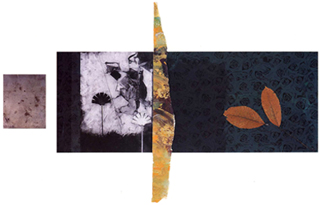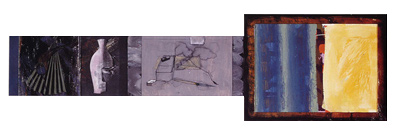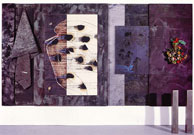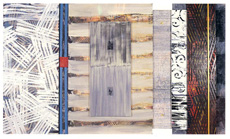text: john milner
difficult rhymes
november 1994
The large paintings, the collages and the prints which Christopher Jones has assembled here for this exhibiton are all interrelated. Yet each series of works is also complete in itself and every work can stand close scrutiny. They are linked most closely by their theme which runs from the least detail of his collages to the imposing canvases which measure up to four metres across. The collages form a halfway house between sketchbook studies and major canvases, and as a result of this they show the artist in the process of selecting and editing the plethora of his daily experiences to make of them a more resolved and considered compositon. The experimental nature of the collages gives them a fresh immediacy which still retains the wide range of possibilities and references that are both slimmed down and also strengthened in the transposition onto a large scale.

The diary-like succession of collages appears to recall days of intense or poetic experience that proceed through a cumulative narrative that has no plot. In this respect they recall Pierre Bonnard who drew this way, often on the pages of a diary, as if there were enough in the shifting texture, light and colour of his own interior to provide a limitless theme for his paintings. Christopher Jones' paintings also indicate fragments or aspects of rooms and interiors that may appear lavish or tawdry, revealing a more sinister atmosphere of falseness, decay and even deceit.
Jones uses many materials and textures in both his collages and his paintings. He uses metal sheet and soft deep black materials, fragments of photographs, etchings or drawings, each of which carries its own associations of experience, so that he can extend the sense of sight to include a sense of touch, taste, smell and the more subtle sensations that memory preserves when recalling the views and perspectives of interiors once visited whose inhabitants remain unseen or barely glimpsed. This painter uses many means to tease out suggestive atmospheres and to install them in the viewer's experience. He is precise in his use of every touch from a shraply etched images to a smearing of colours which lend his work conviction and credibility.
The collages and paintings abandon the conventional unity of time and space which the single rectangular frame format exemplifies. This makes the viewer search through multiple, intersecting and overlapping sequences of frame, view through, scanning and wide-angle survey. Jones speaks of stretching the rectangles as far as possible without losing the coherance of the whole and this explains in part the compartmentalised sections of his wide collages.

By framing sections one within another, like intersecting memories or glimpses, he brings out the full narrative potential of his structure. As the eyes explore each area and scale, they mimic the shifts of focus and attention that characterise the investigation of an actual room, so that traces of glossy black or shimmering green may be interpreted as signs of human habitation. Shifting viewpoints of this kind are familiar in film and video and Jones edits as a film director might with an eye to composition but with another to continuity, pace and rhythm.
 |
Ritual Exchange moves decisively into three-dimensional space with its incorporation of a blanket and metal posts, presented a little like relics: the suggestion is of poverty, suffering or deprivation. It smells of hope and anxiety. Cocoon relies more upon painted texture and pattern, but the layering and sectioning of the painting disturbs the convention of a single picture surface to admit a new complexity. Each canvas can be viewed frontally and its surface textures, mounted relic-like image or object encourages this. But each canvas also has its place along the horizontal extension of the format, like words in a sentence, or scenes in a film, each with its own function. Some surfaces seem frail, some dominant, some vigorous, some bright. |
|
|
If the grandiose spaces depicted in Jones' monumental canvases have in any sense had occupants, they are known only through the atmospheric suggestions embedded in textures and colours, and the fragments of imagery revealed in the big multi-layered canvases that dominate the exhibition. Black dominates the paintings, but is less pervasive in the collages and prints. Jones is well able to make black a dead and sinister colour or to give it an electric brilliance. He can twist it confidently into the railing of a balcony or pile it up into a hard and glossy surface like a rain wet road. This is all that remains of his protagonists: they have gone away leaving behind the space they knew so intimately and that they made through their own actions and circumstances. |
|
Over recent years Jones' propensity for travel has informed and nourished his practice but in this body of new work he shows he is also an acutely perceptive observer of the unwitting evidence of interiors and of the people who made them. |
||
